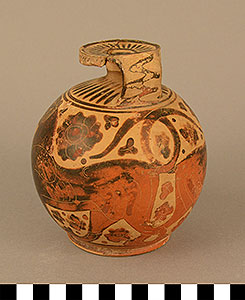Aryballos
1922.01.0111
Detailed Images
Basic Information
| Artifact Identification | Aryballos (1922.01.0111) |
|---|---|
| Classification/ Nomenclature |
|
| Artist/Maker | Attibuted to the Painter of Berlin F 1090 by D. Amyx. |
| Geographic Location | |
| Period | Archaic Period (800 - 480 BC) |
| Date | 580 BCE |
| Culture | Greek, Corinthian |
| Location | On Exhibitin the Ancient Mediterranean exhibit |
Physical Analysis
| Dimension 1 (Height) | 14.0 cm |
|---|---|
| Dimension 2 (Diameter) | 12.4 cm |
| Dimension 3 (Diameter) | 7.8 cm |
| Weight | 292 g |
| Measuring Remarks | Under Review |
| Materials | Ceramic--Terracotta, Pigment--Glaze |
| Manufacturing Processes | Throwing, Firing, Glazing |
Research Remarks
| Description | N/A |
|---|---|
| Published Description | Under Review |
| Bibliography | Wisseman, Sarah U. Corpus Vasorum Antiquorum. Philipp von Zabern: Mainz, 1989. Page 6, Plate 4 , 1-2. |
Artifact History
| Credit Line/Dedication | University of Marburg Archaeological Seminar Collection |
|---|---|
| Reproduction | No |
Contact
All information about our collection is constantly reviewed and updated. Please contact Dery Martínez-Bonilla, Registrar, if there is any information you are looking for that isn't currently online.
